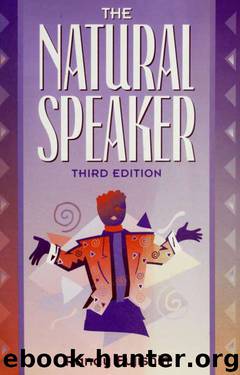The natural speaker by Fujishin Randy

Author:Fujishin, Randy [Fujishin, Randy]
Language: eng
Format: epub
Tags: Public speaking
Publisher: Boston : Allyn and Bacon
Published: 2000-05-12T19:00:00+00:00
84 Chapter 6
a visual aid, establishing common ground with the audience, pointing to an historical event, complimenting the audience, and stressing the importance of the speech topic. Remember that whatever attention getter you decide on, it should relate directly to the topic, and it should appropriately match the overall tone of the speech. Keep your attention getters relatively short, because the entire introduction should comprise only 10 to 15 percent of your total speaking time.
Preview of Main Points
After you have given your attention getter, you should pause for one or two seconds, then present your preview of main points. The purpose of the preview of main points is to give your audience a foreshadowing of what's to follow in the speech. It prepares their minds to receive the points you will be speaking on. The preview of points should be only one sentence in length. A common mistake is to say too much in the preview, almost giving a minispeech for each point previewed. Keep it brief and to the point. Only one sentence! Here are some examples of acceptable previews of main points:
"The three steps to making cookies are gathering your materials, preparing your ingredients, and, finally, baking the cookies."
"The three parts of the guitar are the head, neck, and body."
"Running can improve your physical stamina, reduce psychological stress, and increase your spiritual awareness."
"The three components of a healthy relationship are caring, communication, and companionship."
After you've given the preview of main points, pause for one or two seconds before you state your first numbered transition. This pause will give your audience time to digest the preview of points.
THE CONCLUSION
After you have finished your final point in the body of the speech, it is important to have a two- or three-second pause before you begin your conclusion. Actually say to yourself silently "one thousand one..., one thousand two..., one thousand three" before you start your conclusion. This brief pause will let your audience know that you will be ending shortly.
The first words out of your mouth during the conclusion will be your summary of main points. Please don't say, "In conclusion...," or "I guess
Download
This site does not store any files on its server. We only index and link to content provided by other sites. Please contact the content providers to delete copyright contents if any and email us, we'll remove relevant links or contents immediately.
Cecilia; Or, Memoirs of an Heiress — Volume 1 by Fanny Burney(32412)
Cecilia; Or, Memoirs of an Heiress — Volume 3 by Fanny Burney(31821)
Cecilia; Or, Memoirs of an Heiress — Volume 2 by Fanny Burney(31800)
The Great Music City by Andrea Baker(31248)
We're Going to Need More Wine by Gabrielle Union(18950)
All the Missing Girls by Megan Miranda(15488)
Pimp by Iceberg Slim(14317)
Bombshells: Glamour Girls of a Lifetime by Sullivan Steve(13949)
Talking to Strangers by Malcolm Gladwell(13184)
Norse Mythology by Gaiman Neil(13168)
Fifty Shades Freed by E L James(13144)
For the Love of Europe by Rick Steves(12629)
Mindhunter: Inside the FBI's Elite Serial Crime Unit by John E. Douglas & Mark Olshaker(9159)
Crazy Rich Asians by Kevin Kwan(9146)
The Lost Art of Listening by Michael P. Nichols(7387)
Enlightenment Now: The Case for Reason, Science, Humanism, and Progress by Steven Pinker(7161)
The Four Agreements by Don Miguel Ruiz(6596)
Bad Blood by John Carreyrou(6518)
Weapons of Math Destruction by Cathy O'Neil(6116)
